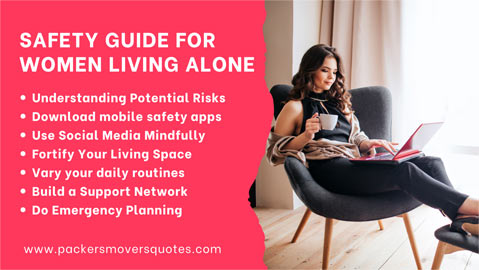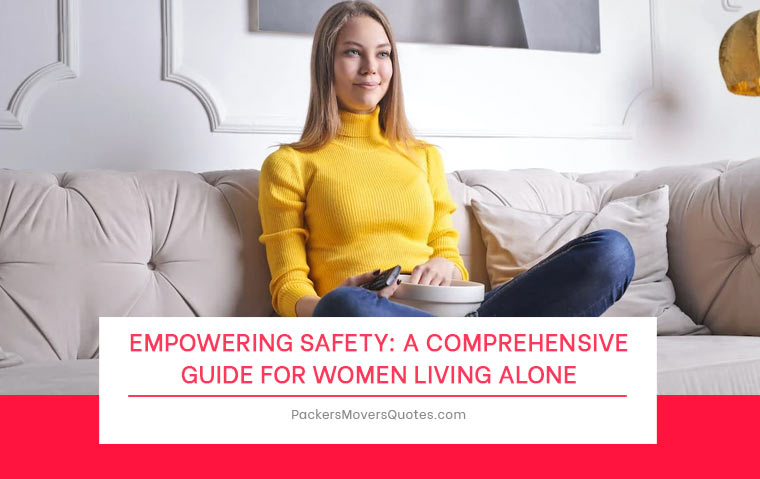Embarking on the journey of living alone as a woman is empowering, yet safety is of utmost importance. In the vast expanse of autonomy, the need for safety becomes paramount—a challenge that calls for strategic solutions and empowered choices. This guide offers in-depth safety tips to ensure peace of mind and a secure living environment.
Understanding Potential Risks
Navigating the path of living alone requires a keen awareness of potential risks. This section sheds light on recognizing vulnerabilities in your living environment, empowering you to proactively address and overcome these challenges.
Recognizing Vulnerabilities
Living alone can make you more susceptible to certain vulnerabilities. Identify potential risks such as poorly lit entryways, secluded parking areas, or blind spots in your building. Understanding these vulnerabilities is the first step in creating a safer living space.
Neighbourhood Assessment
Conduct a thorough assessment of your neighborhood’s safety. Research crime rates, explore the availability of street lighting, and take note of the proximity to emergency services. Engage with neighbors to gather insights into any security concerns they may have encountered.
Fortifying Your Living Space
Your home is your sanctuary, and fortifying it is crucial for your safety. This section details security measures and smart home technologies, empowering you to transform your living space into a secure haven.
Security Measures
Upgrade your home’s security by installing robust door locks, deadbolts, and window bars. Consider reinforcing entry points with security film to prevent break-ins. Additionally, invest in a reliable home security system with 24/7 monitoring for added protection.
Smart Home Technology
Leverage smart home technology to enhance security. Install smart doorbells with built-in cameras for real-time monitoring. Set up smart lighting systems that mimic your daily routines, giving the impression that someone is always home. Smart locks controlled via mobile apps provide an extra layer of control.
Emergency Planning
Develop a comprehensive emergency plan for various scenarios. Identify escape routes and establish a designated meeting place outside your residence. Share this plan with a trusted friend or family member so they can assist in case of an emergency.
Personal Safety Habits
Your daily habits play a crucial role in ensuring your safety while living alone. This section guides you through cultivating mindful social media use, varying your routines, and screening service providers to enhance your personal safety habits.
Mindful Social Media Use
Be cautious about sharing personal information on social media platforms. Avoid disclosing your location in real-time, especially when you are alone at home. Review privacy settings and limit the visibility of personal details.
Varying Daily Routines
To avoid predictability, vary your daily routines. Change the timing of your walks, workouts, or grocery shopping. This makes it challenging for anyone observing to predict your movements and routines, reducing the risk of becoming a target.
Screening Service Providers
Thoroughly vet service providers before granting access to your home. Verify their credentials, ask for references, and use reputable platforms that conduct background checks. If in doubt, don’t hesitate to ask for identification before allowing entry.
Strengthening External Connections
Building a network of support is essential for a secure living experience. This section explores the importance of establishing strong connections with neighbours and maintaining a list of emergency contacts to foster a sense of community.
Building a Support Network
Establish strong connections with neighbours, creating a sense of community and mutual support. Share contact information with trustworthy neighbours so you can quickly reach out in case of an emergency. A vigilant community is a safer community.
Emergency Contacts
Maintain an updated list of emergency contacts, including local authorities, friends, and family. Store these numbers in your phone and keep a physical copy in an easily accessible location, like on the fridge or by the front door.
Personal Safety Products
Equipping yourself with the right tools enhances your ability to stay safe. This section delves into the importance of self-defence tools and mobile safety apps, providing practical insights for choosing and utilizing personal safety products.
Self-Defense Tools
Consider carrying self-defence tools such as pepper spray, personal alarms, or a portable panic button. Take self-defence courses to learn how to use these tools effectively and build confidence in your ability to protect yourself.
Mobile Safety Apps
Download mobile safety apps that offer features such as real-time location sharing, emergency SOS buttons, and automatic check-ins. Familiarize yourself with these apps and set up emergency contacts who will be notified in case of any safety concerns.
Mental and Emotional Well-being
Ensuring your mental and emotional well-being is paramount for a secure and confident living experience. This section explores building confidence, seeking professional support, and prioritizing your mental health.
Building Confidence
Cultivate a strong sense of self-confidence. Practice assertiveness in your daily interactions, trust your instincts, and project confidence in your body language. This can act as a deterrent to potential threats.
Seeking Professional Support
Consider enrolling in self-defence classes to acquire practical skills and strategies for personal safety. Additionally, explore counselling services to address any emotional concerns related to living alone. Joining community safety programs can provide valuable resources and support.
Conclusion

Empower yourself with knowledge and proactive measures to enhance safety while living alone. By recognizing vulnerabilities, fortifying your living space, adopting personal safety habits, strengthening external connections, utilizing personal safety products, and prioritizing mental and emotional well-being, you can create a secure and confident living environment.
